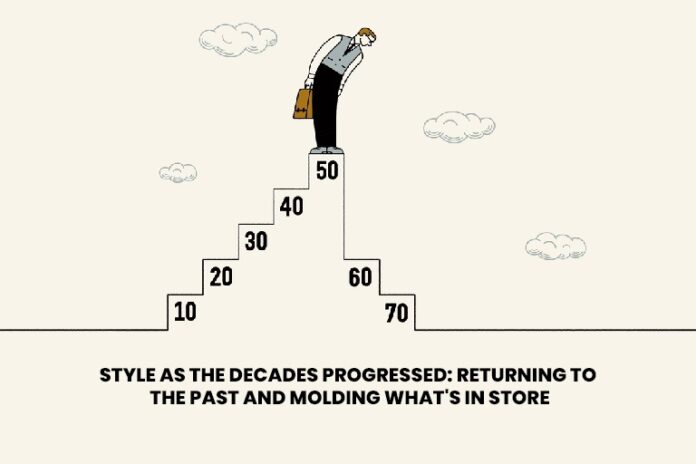Design is a dynamic and steadily developing type of self-articulation that plays had a huge impact in molding societies and social orders from the beginning of time. From the thundering 1920s to the energetic 1980s and then some, every ten years has brought its interesting patterns and styles, making a permanent imprint on the design scene. Over the natural course of time, these patterns frequently think of themselves as resurrected, reevaluated, and reconsidered, advancing once again into the cutting-edge style scene. Today, we dive into the style as the decades progressed, investigating how the previous proceeds to impact and shape what’s in store.
- 1920s:
The Thundering Twenties the 1920s denoted a period of freedom and social change, and design reflected this soul. The notable flapper dresses with their dropped abdomens, beaded embellishments, and bordered hemlines exemplified the recently discovered opportunity of ladies. Craftsmanship Deco designs, cloche caps, and long pearl necklaces were likewise noticeable during this period, mirroring the style and plushness of the time.
- 1930s:
The Brilliant Time of Hollywood the 1930s carried with it the Brilliant Period of Hollywood, where marvelousness and refinement governed the cinema. The design of this period oozed style and gentility. Inclination cut outfits, figure-embracing outlines, and heartfelt textures like silk and glossy silk were well known. The impact of Workmanship Deco proceeded, with mathematical examples and metallic accents enhancing dresses and extras.
- 1940s:
War-Time Style the 1940s were overwhelmed by The Second Great War, and design needed to adjust to the restrictions forced by apportioning and shortage of materials. Utility apparel and common sense became the overwhelming focus. Ladies’ style embraced the “make do and retouch” ethos, with custom-fitted suits, knee-length skirts, and pullovers becoming well known. Striking shoulder braces and energetic themes were likewise predominant, mirroring the versatility and strength of the time.
- 1950s:
The Ascent of Rock ‘n’ Roll the 1950s saw a social shift with the development of wild ‘music, and design stuck to this same pattern. Ladies’ style saw the recovery of gentility with full skirts, clamped waistlines, and slips, while men’s design stressed custom-fitted suits and greaser-propelled looks. Poodle skirts, saddle shoes, and calfskin coats became notorious images of this time’s defiant soul.
- 1960s:
The Swinging Sixties the 1960s got an unrest design, dismissing the congruity of the past and embracing youth culture. The mod style with its strong examples of scaled-down skirts, and shift dresses overwhelmed the world. Hallucinogenic prints, chime base jeans, and brilliant extras became inseparable from the nonconformity development. It was a period of trial and error and pushing limits.
- 1970s:
The Disco Fever the 1970s disco time is associated with its flashy style and sparkling nightlife. The disco style included wide-legged pantsuits, stage shoes, and gleaming textures like lurex and sequins. Ringer sleeves, maxi dresses, and hallucinogenic prints kept on saying something. The style of this decade was about self-articulation and embracing singularity.
- 1980s:
The 10 Years of Abundance the 1980s was a period characterized by overabundance, portrayed by intense tones, larger-than-average outlines, and power dressing. Shoulder braces, neon tones, leg warmers, and corrosive-washed denim were notable components of ten years. The design turned into an impression of the thriving economy and the longing for progress. Punk and new wave styles additionally arose, including a component of resistance.
- 1990s:
The Ascent of Street wear and Moderation The 1990s got shifted style towards an additional loose and relaxed tasteful. Impacted by hip-jump culture, street wear turned into a predominant pattern. Loose pants, realistic shirts, hoodies, and tennis shoes became well-known staples. Simultaneously, moderation likewise arose as a counter to the overabundance of the 1980s. Clean lines, nonpartisan tones, and straightforward outlines characterized this pattern, embodied by creators like Calvin Klein and Jil Sander.
- 2000s:
The Period of Mainstream Society and Force to be reckoned with Design the 2000s saw the ascent of big-name culture and the impact of online entertainment. The design turned out to be more available and speedy. Low-ascent pants, tank tops, and velour tracksuits acquired prevalence. Brands like Succulent Couture and Von Dutch became famous. The period was set apart by a combination of styles, blending components from earlier a very long time in with a contemporary curve. It was a period of trial and error and independence.
- 2010s:
The Period of Athleisure and Economical Design the 2010s saw the ascent of athleisure, mixing athletic apparel with ordinary style. Stockings, tennis shoes, and larger-than-average hoodies became closet basics. The style business likewise saw a developing familiarity with maintainability. Moral design, eco-accommodating materials, and slow-style developments picked up speed. Classic and thrift clothing acquired fame as individuals looked for special and manageable style choices.
- The 2020s and then some:
A Combination of Wistfulness and Development As we enter the 2020s, the style keeps on being a combination of sentimentality and development. There is a recovery of retro styles, with components from the ’70s, ’80s, and ’90s getting back in the saddle. Rare-motivated outlines, proclamation embellishments, and striking prints are seen on runways and in road style. Nonetheless, manageability and mechanical progressions are additionally driving the business. Cutting-edge textures, 3D printing, and virtual design encounters are molding the eventual fate of style. The eventual fate of style is probably going to be a harmony between embracing the past and embracing development. The impact of earlier many years will endure, however with a new point of view and new understanding. As cultural qualities and inclinations develop, the design will keep on mirroring these changes. The inclusivity development, body energy, and social variety will assume an essential part in forming the future style scene.
- Cultural Effects on Style:
Style is affected by the progression of time as well as by social movements and worldwide occasions. For instance, the ascent of globalization in the late twentieth century prompted the trading of thoughts and styles between various societies. Conventional pieces of clothing and examples from different districts found their direction into standard style, making a rich embroidery of worldwide impacts.
Conclusion:
As we push ahead, the fate of style will probably be formed by these continuous patterns. Manageability, mechanical headways, social variety, and inclusivity will keep on being the main thrusts in the business. By returning to the past, gaining from it, and integrating these qualities into the future, the design will stay a strong type of self-articulation and an impression of our steadily developing society.
Read more – Breaking Orientation Obstructions in Style: Reclassifying Standards and Embracing Smoothness
Read more – The Upsides and Downsides of Vehicle Sharing Administrations: A Complete



